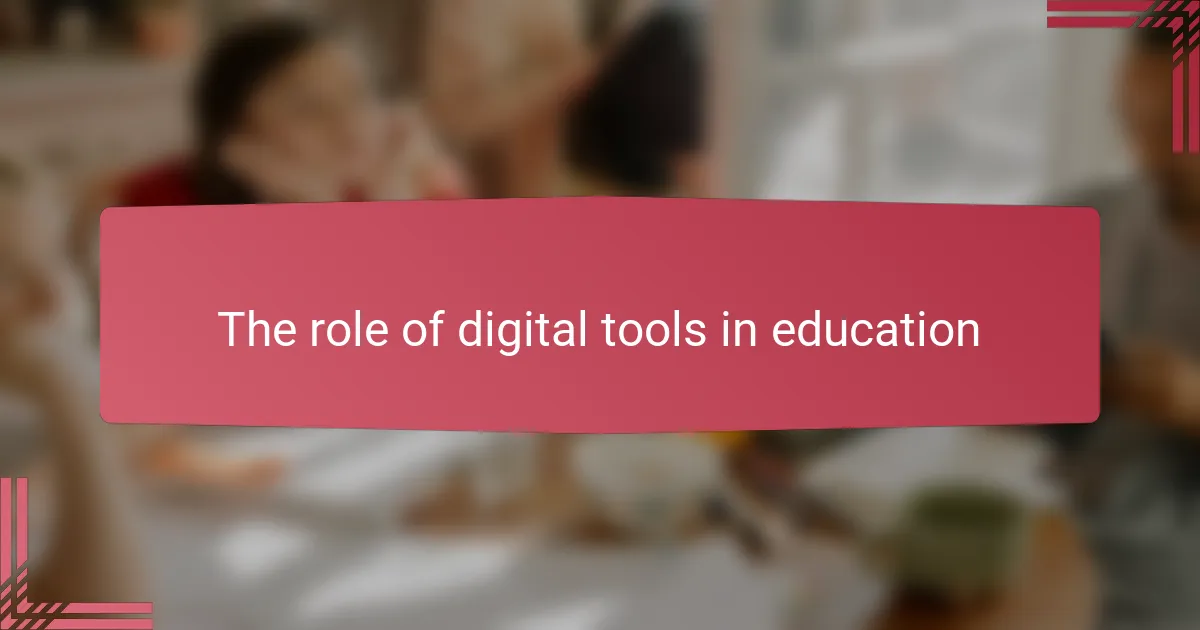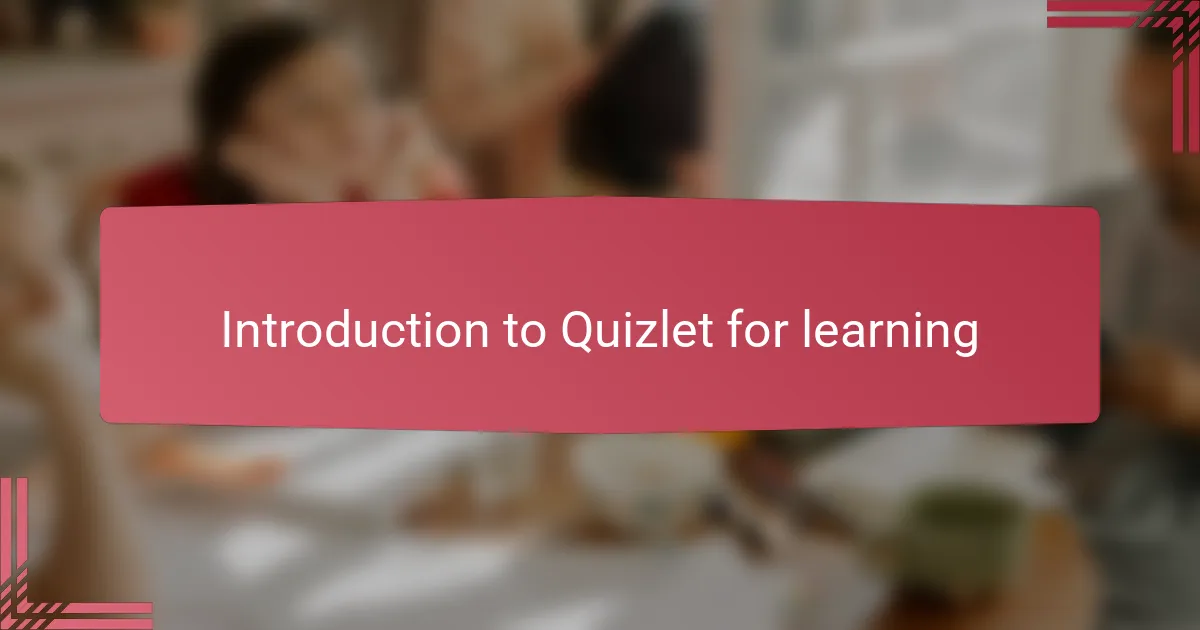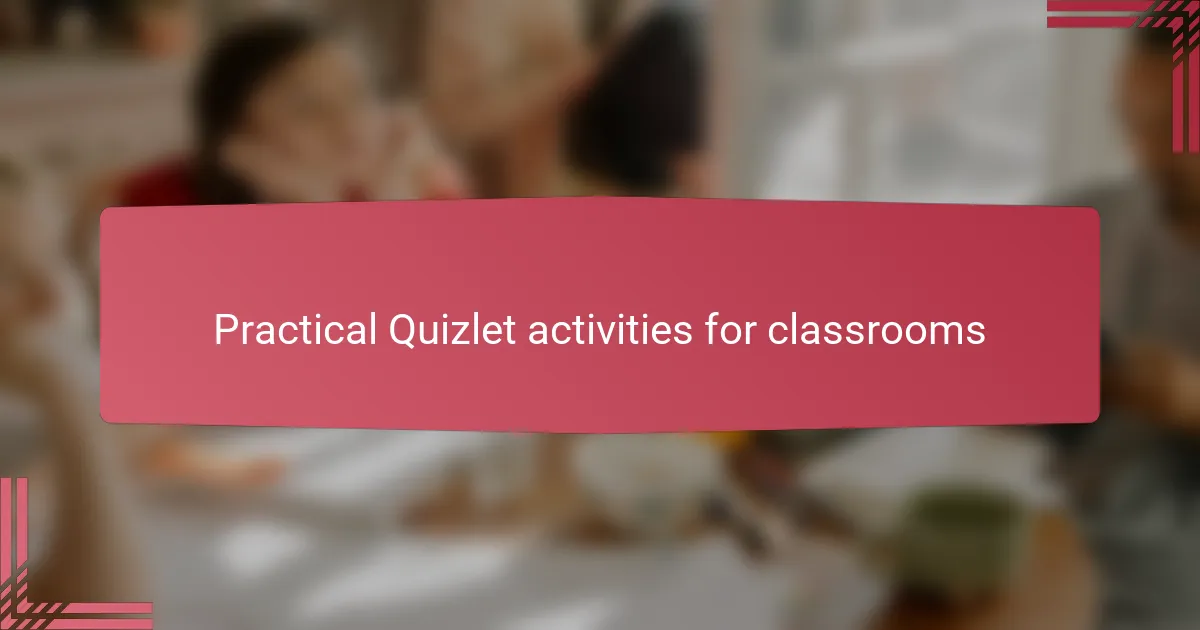Key takeaways
- Activist teacher resources promote equity and social justice, fostering critical thinking and community in classrooms.
- Digital tools enhance student engagement and provide personalized learning experiences, bridging gaps in traditional education.
- Quizlet’s interactive features, like live games and customizable flashcards, boost student motivation and ownership of learning.
- Addressing challenges with tech in classrooms requires inclusive practices and strategies to manage content effectively, ensuring all students stay engaged.

Understanding activist teacher resources
Activist teacher resources are more than just lesson plans or tools—they reflect a commitment to equity and social justice in the classroom. I’ve found that tapping into these resources can transform ordinary teaching moments into opportunities for empowerment and critical thinking. Have you ever noticed how a simple resource can spark a powerful conversation that challenges students to see the world differently?
To me, these resources serve as catalysts that encourage educators to embed real-world issues into their teaching. They push us to move beyond textbooks and ask: How can my lessons inspire students to become thoughtful, engaged citizens? Drawing from my experience, I’ve seen how activist resources make learning relevant and fuel students’ intrinsic motivation to participate and take action.
What strikes me most is how these tools foster a sense of community in the classroom. They invite everyone to share their voices and stories, which creates more inclusive and dynamic learning environments. Isn’t that what teaching should be about—building connections that matter while empowering young minds to question and grow?

The role of digital tools in education
Digital tools in education have changed the way we connect with students, making learning more interactive and accessible. From my own classroom experience, I’ve noticed that when students use technology, they often show greater curiosity and engagement because these tools meet them where they already spend a lot of their time.
I’ve often wondered why some students thrive more when digital resources are involved. It seems to me that these tools offer immediate feedback and personalized pacing, which keeps students motivated and confident. Have you ever seen a student light up when they instantly understand a concept through an app or interactive quiz? That moment says a lot about the power of digital learning.
Moreover, digital tools break down barriers that traditional classrooms sometimes struggle with. They give students of different backgrounds and learning styles equal opportunities to participate. It reminds me why I believe technology isn’t just a supplement—it’s a vital bridge to equity in education.

Introduction to Quizlet for learning
When I first introduced Quizlet to my students, I was struck by how naturally they took to it. This digital platform transforms studying into an interactive experience, where flashcards, games, and quizzes keep learners actively engaged rather than passively scrolling through notes. Have you ever seen students challenge each other to master content while barely realizing they’re studying? That’s the kind of motivation Quizlet sparks in the classroom.
What I appreciate most about Quizlet is its flexibility. From my experience, students can learn at their own pace, revisiting tricky concepts with instant feedback that guides them without pressure. This personalized approach makes learning feel less like a chore and more like a game, encouraging persistence and self-confidence. Isn’t that what we want—to see students take ownership of their education?
Quizlet also brings a social element to learning that often goes missing in digital tools. I’ve noticed how students enjoy sharing sets and competing in live quizzes, which builds camaraderie and makes studying feel less isolating. It’s these moments, when learning becomes collaborative and fun, that truly highlight why Quizlet is a powerful resource for motivating students.

Motivating students with Quizlet methods
One of the methods I’ve found effective with Quizlet is integrating its live games into lessons. Watching students compete in real time, their faces light up with excitement, makes me realize how turning review into a friendly challenge boosts their drive to learn. Don’t we all perform better when there’s an element of fun and teamwork involved?
Another approach I often use is customizing sets that reflect students’ interests or current events. I’ve seen motivation soar when learners recognize the relevance of what they’re studying—it stops being abstract and starts feeling personal. Have you tried tailoring content in this way? It really transforms passive studying into active engagement.
Finally, encouraging students to create their own flashcards has been a game changer for motivation in my class. By crafting questions and answers themselves, they become more invested in the material, and it’s rewarding to see their confidence grow as they take charge of their learning journey. Isn’t empowering students with choice exactly what motivates deep learning?

Practical Quizlet activities for classrooms
One activity that’s worked well for me is starting class with a quick Quizlet Live session. I can feel the energy shift as students huddle to collaborate, racing to match terms and definitions. It’s amazing how a few minutes of friendly competition gets everyone focused and ready to dive deeper into the lesson.
I also like assigning personalized flashcard sets as homework, especially when I see students creating their own decks based on what puzzles them the most. This not only reinforces their learning but also sparks a sense of ownership—when students make the content their own, motivation naturally follows. Have you noticed how confidence grows when learners feel their insights matter?
Sometimes, I mix in Quizlet’s various game modes, like Match or Gravity, during independent work time. These games add variety and keep students engaged without feeling like extra work. From my experience, this balance of challenge and fun helps sustain motivation across different learning paces and styles. Isn’t that the secret to keeping the classroom buzzing with enthusiasm?

Overcoming challenges using Quizlet
Challenges inevitably crop up when introducing Quizlet, especially with students who initially resist new tech or prefer traditional methods. I remember one reluctant learner who scoffed at digital flashcards but, after a few competitive Quizlet Live rounds, began asking for more. Have you seen that shift happen—from skepticism to enthusiasm? It’s rewarding to witness how engaging tools can break through initial doubts.
Another hurdle I often face is ensuring all students access Quizlet equally, given varying home internet and device availability. To tackle this, I make a point to use Quizlet during class time, turning potential inequality into a shared classroom experience. Doesn’t it feel great when technology becomes a bridge rather than a barrier? In my experience, creating inclusive opportunities like this fosters motivation and avoids leaving anyone behind.
Sometimes, I notice students getting overwhelmed by the sheer volume of content on Quizlet sets. What’s helped me is guiding them to break study material into smaller, manageable chunks within the platform. By modeling this approach, I’ve seen students move from frustration to confidence. Have you tried chunking content before? It’s a small change that can make a big difference in keeping motivation afloat.